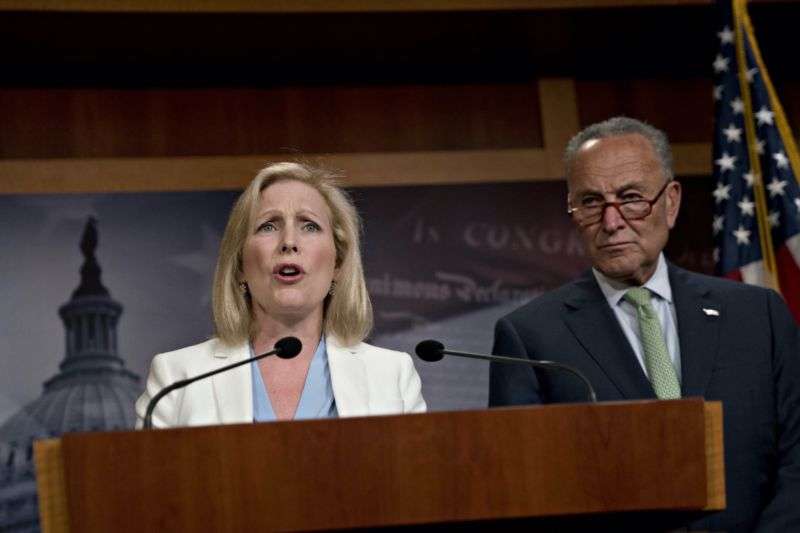
FCC shuts New York out of $20B broadband fund, and senators are angry

The Federal Communications Commission has unfairly shut New York state out of a planned $20.4 billion broadband-funding program, US Senate Minority Leader Chuck Schumer (D-N.Y.) and Sen. Kirsten Gillibrand (D-N.Y.) wrote in a letter to FCC Chairman Ajit Pai last week.
ISPs in 48 states are eligible for funding in the FCC rural-broadband program, which will distribute the money over 10 years to providers that expand their networks to new homes and businesses. The FCC said it blocked New York and Alaska from Phase I of the program “because of previously established programs to fund rural broadband in these states.” (Phase I will distribute $16 billion of the $20.4 billion.)
The FCC previously established a separate funding program for Alaska with $1.5 billion over 10 years. But Schumer and Gillibrand say New York has only gotten its fair share of nationwide FCC programs, rather than something extra.
“I am disappointed that the FCC chose to exclude millions of New Yorkers from potentially accessing vital broadband Internet services,” Gillibrand said in an announcement Friday. “The FCC’s justification for this is unacceptable. New York shouldn’t be penalized for helping its rural communities get online, and this proposal will only make it harder for rural residents to do just that.”
Schumer and Gillibrand’s letter urged Pai to reverse the decision and let New York-based ISPs participate in the fund, which is supposed to provide broadband access to up to 4 million rural homes and businesses nationwide. “The FCC is undermining New York State’s due process and penalizing New York for proactively creating a program to address unserved communities across the state,” their announcement said.
We contacted Pai’s office Wednesday morning about the Schumer/Gillibrand letter and will update this story if we get a response.
NY previously got $170 million
The FCC previously said it left New York out of the fund because of the existing New York Broadband Program. But that program is funded primarily by state grants, with the FCC committing $170 million over 10 years. New York committed $500 million to the fund.
Even that $170 million wasn’t anything more than what New York was eligible for through standard FCC programs. The money became available because Verizon in 2015 turned down $170 million for New York expansions in the FCC’s Connect America Fund (CAF), which pays for rural-broadband expansion throughout the United States. State officials convinced the FCC to redirect that funding to New York’s state government.
“From the very beginning, I was very clear with the FCC that this $170 million belongs strictly to New York and should be kept here,” Schumer said in a January 2017 announcement.
The new $20.4 billion program, called the Rural Digital Opportunity Fund (RDOF), will replace the CAF. The RDOF and CAF are similar in that both pay ISPs to expand their broadband networks, awarding the money via reverse auctions, and both funds are paid for by Americans through fees imposed on phone bills.
In the same year that Verizon declined funding, the FCC awarded $9 billion over six years to ISPs in 46 states, including other ISPs in New York.
In another auction in 2018, 45 states got funding that totaled $1.49 billion over 10 years. New York and Alaska were excluded from that auction.
“The federal government should be investing—not divesting—in Upstate New York rural Internet access,” Schumer said. “Just because New York participates in certain federal rural broadband expansion programs certainly doesn’t mean it should lose access to others. It makes absolutely no sense to punish New York for taking positive steps to address broadband access.”
Broadband gap in rural New York
About 98.4 percent of New York state’s 19.8 million residents live in areas with access to home broadband with 25Mbps download speeds and 3Mbps upload speeds, according to an FCC broadband deployment report. The numbers are 99.9 percent in urban New York and 87.1 percent in rural New York.
About 80.5 percent of Alaska’s 740,000 residents live in areas with access at that speed, the report said. The numbers are 96.4 percent in urban Alaska and 51.6 percent in rural Alaska.
Those percentages may be misleading, as FCC broadband-access data is widely known to be inaccurate, and the commission has pledged to collect more accurate data from ISPs in the future.
The first RDOF reverse auction, for $16 billion over 10 years, is slated to begin later this year with the FCC saying it plans to “target those areas that current data confirm are wholly unserved.” A second auction would be held in the future to distribute the rest of the money, presumably after the FCC has more accurate data on which parts of the US lack broadband access.
ISPs in each eligible state can apply for funding to support broadband networks offering at least 25Mbps download and 3Mbps upload speeds, or for higher tiers including 50Mbps/5Mbps, 100Mbps/20Mbps, and 1Gbps/500Mbps. As we previously wrote, the FCC plan disappointingly allows ISPs to impose data caps of 250GB per month on the 25Mbps/3Mbps and 50Mbps/5Mbps tiers. ISPs that pledge to offer service at the higher levels of 100Mbps/20Mbps and 1Gbps/500Mbps will get more funding and be required to allow at least 2TB of data usage each month.




